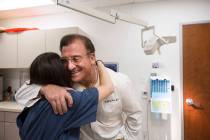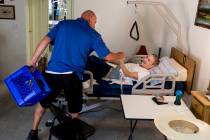Hospitals endanger lives on daily basis
You can do it when you’re not in the middle of the storm – plan, make comparisons, put things in perspective.
It’s what executives at New York University’s Langone Medical Center could have done long ago.
So they didn’t end up with flooded backup generators failing during Hurricane Sandy, so the staff didn’t have to perform heroically to lead 300 patients to safety.
What was crystallized at Langone is this: Hospital executives don’t mind placing patients in harm’s way.
Gary Cohn, a trustee at NYU Langone, admitted on TV that the Langone brain trust knew there were problems with the backup generation system, that part of it was in the basement, where it could easily be flooded.
“I am acutely aware that the infrastructure at NYU is somewhat old,” he said. “We do have backup generation facilities. They are not state-of-the-art, they’re not in the most state-of-the-art location. That’s all … well-known by the board of directors of NYU.”
That Cohn also said the hospital is in the midst of a $3 billion campaign to modernize the facilities does not mitigate what was done to patients.
When a storm bears down on an area and meteorologists promise flooding, you don’t knowingly leave patients in buildings where the safety backup is “not state-of-the-art,” hoping the storm misses so you can save money in patient transfer costs.
But gambling with patients’ lives is something hospital executives across the country do daily. What happened at Langone should be the catalyst for Americans to closely examine how health care facilities cavalierly place lives at risk.
While Hurricane Sandy is blamed for the deaths of more than 100 Americans and for a financial loss of about $40 billion, preventable health care errors, including infections, kill as many as 100,000 Americans each year – an average of about 300 people per day – and add $45 billion in costs, according to federal authorities.
In other words, every year it takes less than a week for the man-made disasters in hospitals to kill as many people, 1,800, as died as a result of Hurricane Katrina and less than a month to kill as many people, 8,000, as died in the nation’s greatest natural disaster, the 1900 Galveston Hurricane.
It is unconscionable.
Health care experts have long known that if hospital staff would make some minor adjustments to their routines – such as washing their hands more and cleaning all high-touch surfaces daily with a disinfectant – the infection problem could be significantly minimized. They’ve also known that the adoption and use of safety checklists like those used in the airline industry make it almost impossible for practitioners to operate on the wrong part of the body, reuse syringes, give someone the wrong medication, leave operating equipment inside patients.
But the carnage at many health care facilities continues as too many executives are happy to enable arrogant physicians who believe themselves infallible, doctors who say they’ll take their business elsewhere if too many rules are in place.
And even as infection rates spiral out of control, those same bottom line-conscious executives are quick to cut housekeeping staff, a basic necessity to keep bacteria such as Clostridium difficile in check.
Clostridium difficile infected more than 700 hospitalized Nevadans in 2010. Though 36 Nevadans were listed as dying of it, state authorities admit the number may be much larger because authorities often list a complication of the infection, such as kidney failure, as a cause of death. As many as 30,000 died from it at facilities across the country.
Despite that staggering statistic, the Association for the Healthcare Environment reports hospitals have cut housekeeping budgets by as much as 25 percent in recent years.
That kind of callousness toward the protection of human life – the kind displayed by executives at Langone – creates man-made disasters that can’t be tolerated.
Not only is it past time for strictly enforced uniform regulation in every health care facility as well as complete transparency in reporting infection and error rates – something administrators often lobby intensely against – it is also past time for the sociopaths running far too many facilities to be put on trial for crimes against humanity.
Contact reporter Paul Harasim at pharasim@
reviewjournal.com or 702-387-2908.












